Bc.vc
Bc.vc is another great URL Shortener Site. It provides you an opportunity to earn $4 to $10 per 1000 visits on your Shortened URL. The minimum withdrawal is $10, and the payment method used PayPal or Payoneer.
Payments are made automatically on every seven days for earnings higher than $10.00. It also runs a referral system wherein the rate of referral earning is 10%.- The payout for 1000 views-$10
- Minimum payout -$10
- Referral commission-10%
- Payment method -Paypal
- Payment time-daily
Linkrex.net
Linkrex.net is one of the new URL shortener sites.You can trust it.It is paying and is a legit site.It offers high CPM rate.You can earn money by sing up to linkrex and shorten your URL link and paste it anywhere.You can paste it in your website or blog.You can paste it into social media networking sites like facebook, twitter or google plus etc.
You will be paid whenever anyone will click on that shorten a link.You can earn more than $15 for 1000 views.You can withdraw your amount when it reaches $5.Another way of earning from this site is to refer other people.You can earn 25% as a referral commission.- The payout for 1000 views-$14
- Minimum payout-$5
- Referral commission-25%
- Payment Options-Paypal,Bitcoin,Skrill and Paytm,etc
- Payment time-daily
BIT-URL
It is a new URL shortener website.Its CPM rate is good.You can sign up for free and shorten your URL and that shortener URL can be paste on your websites, blogs or social media networking sites.bit-url.com pays $8.10 for 1000 views.
You can withdraw your amount when it reaches $3.bit-url.com offers 20% commission for your referral link.Payment methods are PayPal, Payza, Payeer, and Flexy etc.- The payout for 1000 views-$8.10
- Minimum payout-$3
- Referral commission-20%
- Payment methods- Paypal, Payza, and Payeer
- Payment time-daily
Adf.ly
Adf.ly is the oldest and one of the most trusted URL Shortener Service for making money by shrinking your links. Adf.ly provides you an opportunity to earn up to $5 per 1000 views. However, the earnings depend upon the demographics of users who go on to click the shortened link by Adf.ly.
It offers a very comprehensive reporting system for tracking the performance of your each shortened URL. The minimum payout is kept low, and it is $5. It pays on 10th of every month. You can receive your earnings via PayPal, Payza, or AlertPay. Adf.ly also runs a referral program wherein you can earn a flat 20% commission for each referral for a lifetime.Short.am
Short.am provides a big opportunity for earning money by shortening links. It is a rapidly growing URL Shortening Service. You simply need to sign up and start shrinking links. You can share the shortened links across the web, on your webpage, Twitter, Facebook, and more. Short.am provides detailed statistics and easy-to-use API.
It even provides add-ons and plugins so that you can monetize your WordPress site. The minimum payout is $5 before you will be paid. It pays users via PayPal or Payoneer. It has the best market payout rates, offering unparalleled revenue. Short.am also run a referral program wherein you can earn 20% extra commission for life.Clk.sh
Clk.sh is a newly launched trusted link shortener network, it is a sister site of shrinkearn.com. I like ClkSh because it accepts multiple views from same visitors. If any one searching for Top and best url shortener service then i recommend this url shortener to our users. Clk.sh accepts advertisers and publishers from all over the world. It offers an opportunity to all its publishers to earn money and advertisers will get their targeted audience for cheapest rate. While writing ClkSh was offering up to $8 per 1000 visits and its minimum cpm rate is $1.4. Like Shrinkearn, Shorte.st url shorteners Clk.sh also offers some best features to all its users, including Good customer support, multiple views counting, decent cpm rates, good referral rate, multiple tools, quick payments etc. ClkSh offers 30% referral commission to its publishers. It uses 6 payment methods to all its users.- Payout for 1000 Views: Upto $8
- Minimum Withdrawal: $5
- Referral Commission: 30%
- Payment Methods: PayPal, Payza, Skrill etc.
- Payment Time: Daily
Short.pe
Short.pe is one of the most trusted sites from our top 30 highest paying URL shorteners.It pays on time.intrusting thing is that same visitor can click on your shorten link multiple times.You can earn by sign up and shorten your long URL.You just have to paste that URL to somewhere.
You can paste it into your website, blog, or social media networking sites.They offer $5 for every 1000 views.You can also earn 20% referral commission from this site.Their minimum payout amount is only $1.You can withdraw from Paypal, Payza, and Payoneer.- The payout for 1000 views-$5
- Minimum payout-$1
- Referral commission-20% for lifetime
- Payment methods-Paypal, Payza, and Payoneer
- Payment time-on daily basis
Oke.io
Oke.io provides you an opportunity to earn money online by shortening URLs. Oke.io is a very friendly URL Shortener Service as it enables you to earn money by shortening and sharing URLs easily.
Oke.io can pay you anywhere from $5 to $10 for your US, UK, and Canada visitors, whereas for the rest of the world the CPM will not be less than $2. You can sign up by using your email. The minimum payout is $5, and the payment is made via PayPal.- The payout for 1000 views-$7
- Minimum payout-$5
- Referral commission-20%
- Payout options-PayPal, Payza, Bitcoin and Skrill
- Payment time-daily
Wi.cr
Wi.cr is also one of the 30 highest paying URL sites.You can earn through shortening links.When someone will click on your link.You will be paid.They offer $7 for 1000 views.Minimum payout is $5.
You can earn through its referral program.When someone will open the account through your link you will get 10% commission.Payment option is PayPal.- Payout for 1000 views-$7
- Minimum payout-$5
- Referral commission-10%
- Payout method-Paypal
- Payout time-daily
Shrinkearn.com
Shrinkearn.com is one of the best and most trusted sites from our 30 highest paying URL shortener list.It is also one of the old URL shortener sites.You just have to sign up in the shrinkearn.com website. Then you can shorten your URL and can put that URL to your website, blog or any other social networking sites.
Whenever any visitor will click your shortener URL link you will get some amount for that click.The payout rates from Shrinkearn.com is very high.You can earn $20 for 1000 views.Visitor has to stay only for 5 seconds on the publisher site and then can click on skip button to go to the requesting site.- The payout for 1000 views- up to $20
- Minimum payout-$1
- Referral commission-25%
- Payment methods-PayPal
- Payment date-10th day of every month
LINK.TL
LINK.TL is one of the best and highest URL shortener website.It pays up to $16 for every 1000 views.You just have to sign up for free.You can earn by shortening your long URL into short and you can paste that URL into your website, blogs or social media networking sites, like facebook, twitter, and google plus etc.
One of the best thing about this site is its referral system.They offer 10% referral commission.You can withdraw your amount when it reaches $5.- Payout for 1000 views-$16
- Minimum payout-$5
- Referral commission-10%
- Payout methods-Paypal, Payza, and Skrill
- Payment time-daily basis
Dwindly
Dwindly is one of the best URL Shorten to earn money online. It offers the opportunity to earn money for every person that views links you have created.
Its working is simple. You need to create an account and then shorten any URLs with a click of a button. Go on to share your shortened URLs on the internet, including social media, YouTube, blogs, and websites. And finally, earn when any person clicks on your shortened URL.
They offer the best environment to you for earning money from home. They have even come up with a referral system where you can invite people to Dwindly and earn as much as 20% of their income.
It has built-in a unique system wherein you get the opportunity to increase your daily profits when you analyze your top traffic sources and detailed stats.
Best of all, you get the highest payout rates. The scripts and the APIs allow you to earn through your websites efficiently.
Last but not the least you get payments on time within four days.CPMlink
CPMlink is one of the most legit URL shortener sites.You can sign up for free.It works like other shortener sites.You just have to shorten your link and paste that link into the internet.When someone will click on your link.
You will get some amount of that click.It pays around $5 for every 1000 views.They offer 10% commission as the referral program.You can withdraw your amount when it reaches $5.The payment is then sent to your PayPal, Payza or Skrill account daily after requesting it.- The payout for 1000 views-$5
- Minimum payout-$5
- Referral commission-10%
- Payment methods-Paypal, Payza, and Skrill
- Payment time-daily
Ouo.io
Ouo.io is one of the fastest growing URL Shortener Service. Its pretty domain name is helpful in generating more clicks than other URL Shortener Services, and so you get a good opportunity for earning more money out of your shortened link. Ouo.io comes with several advanced features as well as customization options.
With Ouo.io you can earn up to $8 per 1000 views. It also counts multiple views from same IP or person. With Ouo.io is becomes easy to earn money using its URL Shortener Service. The minimum payout is $5. Your earnings are automatically credited to your PayPal or Payoneer account on 1st or 15th of the month.- Payout for every 1000 views-$5
- Minimum payout-$5
- Referral commission-20%
- Payout time-1st and 15th date of the month
- Payout options-PayPal and Payza
Fas.li
Although Fas.li is relatively new URL Shortener Service, it has made its name and is regarded as one of the most trusted URL Shortener Company. It provides a wonderful opportunity for earning money online without spending even a single $. You can expect to earn up to $15 per 1000 views through Fas.li.
You can start by registering a free account on Fas.li, shrink your important URLs, and share it with your fans and friends in blogs, forums, social media, etc. The minimum payout is $5, and the payment is made through PayPal or Payza on 1st or 15th of each month.
Fas.li also run a referral program wherein you can earn a flat commission of 20% by referring for a lifetime. Moreover, Fas.li is not banned in anywhere so you can earn from those places where other URL Shortening Services are banned.Al.ly
Al.ly is another very popular URL Shortening Service for earning money on short links without investing any single $. Al.ly will pay from $1 to $10 per 1000 views depending upon the different regions. Minimum withdrawal is only $1, and it pays through PayPal, Payoneer, or Payza. So, you have to earn only $1.00 to become eligible to get paid using Al.ly URL Shortening Service.
Besides the short links, Al.ly also runs a referral program wherein you can earn 20% commission on referrals for a lifetime. The referral program is one of the best ways to earn even more money with your short links. Al.ly offers three different account subscriptions, including free option as well as premium options with advanced features.Cut-win
Cut-win is a new URL shortener website.It is paying at the time and you can trust it.You just have to sign up for an account and then you can shorten your URL and put that URL anywhere.You can paste it into your site, blog or even social media networking sites.It pays high CPM rate.
You can earn $10 for 1000 views.You can earn 22% commission through the referral system.The most important thing is that you can withdraw your amount when it reaches $1.- The payout for 1000 views-$10
- Minimum payout-$1
- Referral commission-22%
- Payment methods-PayPal, Payza, Bitcoin, Skrill, Western Union and Moneygram etc.
- Payment time-daily
Linkbucks
Linkbucks is another best and one of the most popular sites for shortening URLs and earning money. It boasts of high Google Page Rank as well as very high Alexa rankings. Linkbucks is paying $0.5 to $7 per 1000 views, and it depends on country to country.
The minimum payout is $10, and payment method is PayPal. It also provides the opportunity of referral earnings wherein you can earn 20% commission for a lifetime. Linkbucks runs advertising programs as well.- The payout for 1000 views-$3-9
- Minimum payout-$10
- Referral commission-20%
- Payment options-PayPal,Payza,and Payoneer
- Payment-on the daily basis
Linkshrink
Linkshrink URL Shortener Service provides you an opportunity to monetize links that you go on the Internet. Linkshrink comes as one of the most trusted URL Shortener Service. It provides an advanced reporting system so that you can easily track the performance of your shortened links. You can use Linkshrink to shorten your long URL. With Linkshrink, you can earn anywhere from $3 to $10 per 1000 views.
Linkshrink provides lots of customization options. For example, you can change URL or have some custom message other than the usual "Skip this Ad" message for increasing your link clicks and views on the ad. Linkshrink also offers a flat $25 commission on your referrals. The minimum payout with Linkshrink is $5. It pays you through PayPal, Payza, or Bitcoin.
Friday, March 29, 2019
(Latest) Top 19 Best Highest Paying URL Shortener To Earn Money
Digital Disorganisation & Parenting: Part 1
 |
| Messy bedroom via zmeed.info |
'Tidy your room!'
'How do you find anything in here?'
'Pick up after yourself!'
What does this have to do with parents?
The Fundamental 4
Be a role model of digital organisation
All you need to do is commit 10 minutes a day, until you have the fundamental four covered, then once you've recovered from the blissful sense of catharsis, move on to the others...
Now you can rest assured that you no longer need to just nag your kids to pick up after themselves, and tidy up their bedroom, but also that they need to clear out their desktops, tidy up their drive and organise their bookmarks as well! :)
One more thing...
- Keep your passwords secret, your children should not know your passwords!
- Note passwords are plural, you should have a different password for every account you use.
Storium Basics: Challenges And Cards
Storium is played, primarily, by making moves that lay cards onto challenges. These cards tell the story, move by move, of what happens during the challenge.
When you play a card, write a move explaining what your character does, and how those actions impact the challenge.
The effect depends on the card you played. Strength cards improve the situation covered by the challenge. Weakness cards make it worse. Neutral cards, which might be subplots, assets, or goals, push it closer to conclusion without making things feel better or worse.
To think of it from another angle: Challenges have Strong outcomes and Weak outcomes. A Strength card pushes the challenge closer to the Strong outcome, and a Weakness card pushes it closer to the Weak outcome. A Neutral card pushes it closer to a conclusion - a Neutral card doesn't change the direction or push it closer to either outcome, but it does shorten the amount of moves left in the challenge. Thus, a Neutral card might feel good if the challenge is trending Strong or bad if the challenge is trending Weak, as you show things continuing along the lines they have been so far.
It is a very good idea, actually, to check the possible outcomes before you play any moves on a challenge. You can do this simply by clicking on the challenge title / challenge card - this will also show some descriptive text, which can help guide your writing as well. The outcomes tell you what the possible range of results of a challenge are, and where you should be focusing your writing. Knowing them in advance gives you something to work towards. You know that if you play a Strength card, you should be writing something that pulls things closer to the Strong outcome, and if you play a Weakness, you should be writing something that pulls things closer to a Weak outcome. This gives the scene more of a feel of a full story, rather than a bunch of independent moves.
When you lay a card, be sure to involve that card in your move—if you play a Strength card labeled "Agile," for instance, your move should be based on your agility in some way, showing how it helps. If you play a Weakness card labeled "Cowardly," your cowardice or tendency to be overcautious should affect things and make them worse somehow. And if you play your subplot, it's a good time to get a little introspective and show how that subplot is driving you to do what you do, or how the events of the game have changed your view of your subplot.
Note that when you're starting out in a game, it's usually easier to play your first move as either a Strength or a Weakness. Subplots are great cards (my favorite type, in fact), but they can be hard to use for your very first move.
Because you know what impact you're having on the challenge when you lay your card, you should go ahead and write that impact. Don't feel that you need to keep to just your actions—write how you changed things.
A lot of narrative power rests with the players here. Don't worry if you don't quite get it right away—it can take some time to learn the right balance, especially if you're used to a tabletop or MUX method where someone other than you determines your results.
There are limits: until all pips on the challenge are filled, neither of the final results of the challenge should happen. For example, let's assume that the following two challenges exist:
- Drive Back the Assault!
- Strong: You and the other defenders solidly repel the enemy army, driving them away from the town with a minimum of damage or casualties. The battle isn't over and the bandit lord still lives, but the town has some breathing room.
- Weak: You drive back the bulk of the army to give the village some breathing room, though the bandit lord still lives. However, several of the bandits break through the defenses and make it into the village proper. There, they light several more fires and snatch whatever limited wealth the villagers have.
- Rescue the Villagers!
- Strong: You manage to get most civilians - including the mayor - further into the village, to relative safety, without any of them getting notably hurt.
- Weak: You get most of the civilians to safety, but a few - including the mayor - are killed either by the bandits or by being trapped among fires started in the midst of the battle.
Likewise, until "Rescue the Villagers!" is finished, you shouldn't state that all the civilians are free of danger, and you shouldn't state that any significant number the civilians have been killed, especially not the mayor.
However, while playing on "Drive Back the Assault!" you might kill some of the bandits on any card play, organize some villagers into a strong defensive line, take down an enemy champion, slip up and let some bandits surround you, get knocked aside and let the bandits get closer...any of these things, and more, are within the bounds of the challenge.
And on "Rescue the Civilians!" you might certainly get some civilians free, kill a bandit or two threatening them, rescue some from a burning building, be unable to find a way past some threatening bandits or into a burning building, or otherwise show the situation developing.
It's a balancing act—the trick is to show development but leave the final conclusion for the last card. Be guided by your own card play as well, of course, and by which Outcome the challenge is headed towards.
When you play the last card on a challenge, you need to write the conclusion. You'll do that based on the result the game displays. Strong or Weak results are written totally by the player.
Take a look at the outcomes above - they state, in low detail, what happens when those challenges conclude Strong or Weak. If you finish the challenge Strong or Weak, the applicable outcome text will show, and you should use it to guide your writing.
For example, if you play the last card on "Rescue the Villagers!" and it finishes Strong, then by the end of your move, it should be clear that most civilians, including the mayor, are in relative safety further into the village and away from the bandit threat, and none are notably injured. How that happens, though, is up to you!
Remember: The challenge outcomes are important. Don't just stick them in at the end of your move - if you're writing the final move of a challenge, involve the outcomes in your move. Make them a central element of that move's story.
An Uncertain result - which happens if there's an even number of Strength and Weakness cards played or if none are played - is written by the narrator. If that comes up, you'll leave the final results open and the narrator will write something for them. I generally advise that in those cases, you pretend you're writing the second-to-last move of the challenge rather than the last.
Though there are only 3 result types—Strong, Weak, and Uncertain—Storium does track the actual number of each card type played, and if more cards of, say, the Strength type are played, it will take more Weakness cards to bring it back to neutral—or vice-versa. In Storium, every card play does matter, even if the results only fall into three basic fields.
And, of course, the scene can feel very different depending on the card play flow. If the group plays 3 Strength cards followed by 4 Weakness cards, the scene will read differently than if it played 1 Strength, 2 Weaknesses, 2 Strengths, and 2 Weaknesses, or some other combination—even though the final result is Weak either way. The first way will feel like a situation that was promising at first and took a drastic disastrous turn from which it never recovered, while the second way will feel like it went back and forth.
In Storium, by default, you can play up to three cards on a single move, and up to three cards per overall scene. This can vary by game based on settings the narrator chooses, but bear it in mind - if you blow all your card plays on a single challenge, you will have a major impact on that challenge...but no impact on the rest of the scene. Sometimes that's entirely right and proper, mind! It's just something to be aware of.
Some narrators will set up special rules regarding card plays - for instance, some narrators want players to generally only play one card at a time. If your narrator has set up rules for how to play cards, be sure to follow them, as they are part of how the narrator sets up the feeling and tone of the game.
For more information on playing on a challenge, see...well, most of the articles I've written. But especially these ones:
- Make an Impact!
- Play to Your Cards
- Take Charge!
- Leaving Things Open
- Address the Challenge
- No Card Play is "Wasted"
- Multi-Card Moves
- Finishing a Challenge: Strong Results
- Finishing a Challenge: Weak Results
- Finishing a Challenge: Uncertain Results (Player Role)
- Writing a Move: Strength and Weakness Cards
- Writing a Move: Neutral Cards
- Reading Ahead: Outcomes as Inspiration
Angry Birds Space V1.2.2 For PC
Angry Birds Space version 1.2.2 - from floating through space to using the gravity of nearby planets to set up spectacular trick shots, Angry Birds Space takes the gameplay that fans already know and love to a totally new level. With brand new birds, brand new superpowers, and a whole galaxy to explore, the sky is no longer the limit!
Thursday, March 28, 2019
D&D 5E On Roll20
I've been running my Cha'alt campaign on Roll20 during lunch hours and slow times at work.
Sometimes, I label or tag these playtest sessions Swords & Wizardry, sometimes old school D&D, or just D&D 5e... because close enough, right?
Well, a lot of drop-in gamers feel entitled to the official by-the-book, rules-as-written version of 5th edition. Some have even dropped out as soon as they discovered that we weren't using character sheets for a one-hour game or that skill checks would be replaced by actual roleplaying.
While I can't totally blame them (I like what I like and have certain expectations, too), I feel they're missing out on a new (to them) D&D experience.
So, this blog post serves two purposes. The first is to give GMs a glimpse at what I've been using for my Roll20 Cha'alt campaign. The second is to alert potential players as to my interpretation of 5e via old school lens.
Let's face it, Roll20 isn't real roleplaying. As Yoda would say, controversial do you find my words? Well, virtual gaming is a Hell of a lot different than the face-to-face variety. So, without further ado...
House-Rules
- Instead of little modifiers, I use Advantage (roll 2d20 and take the highest) when circumstances are favorable and Disadvantage (roll 2d20 and take the lowest) when their unfavorable.
- No character sheets!
- Come prepared with a NAME, RACE, CLASS, ALIGNMENT, and SOMETHING NOTEWORTHY ABOUT YOUR CHARACTER. That's it.
- Whatever race you pick, you can have only one racial ability that helps your character (infra-vision, resistance to charm spells, superior hearing, whatever).
- The 4 basic classes only - Fighter, Wizard, Cleric, and Thief.
- Fighters can add their level to their to-hit roll and damage. Everyone else, you just roll a d20 and hope you roll your opponent's Armor Class or better.
- Damage is per weapon - simple weapons like dagger, sling, club, quarterstaff, whip, and a sharp rock all do 1d4. Medium weapons like short sword, spear, spiked club, rapier, axe, mace, and all bows do 1d6. Large weapons like greataxe, warhammer, trident, halberd, and all types of longswords do 1d10 damage.
- Wizards are restricted to simple weapons or they're at a Disadvantage. Clerics and thieves can use simple and medium weapons, but are at a disadvantage when trying to use large weapons. Fighters can use any weapon they want without penalty.
- I'm still considering high-tech weapons like machines guns and lasers.
- Natural 20 on an attack roll is a critical hit, resulting in double damage!
- Alignment! There are 4 to pick from. If you choose Law, then you believe in order, justice, community, and most likely worship the New Gods, namely the Lords of Light. Those who choose Chaos believe in natural selection, revenge, and individualism up to and including self-deification. They are more likely to honor the Old Gods, such as K'tulu, Yog-Soggoth, and Uba-Sa'athla. Those of a Neutral alignment try to balance Law and Chaos within themselves and recognize both the Old Gods and the New Gods. Unaligned means that you don't give a damn about Law, Chaos, or the Gods; you have your own unique philosophy or passion that guides you through the world.
- Everyone gets 10 HP per level.
- If you reach zero HP, up to negative your level, you're simply unconscious and will recover soon. Once you go past that (-5 HP if your character is 4th level), you're character is dead. Create another one and I'll try to get your new PC back in the game ASAP.
- All HP refresh after a full 8 hours of rest (interruptions are fine, just make it up by sleeping-in a little longer).
- Levels only go up to 10. At 10th level, the PC is at his adventuring peak.
- Characters gain a level after every other adventure.
- Wizards and clerics can use virtually any spell in the Player's Handbook that's equal to their character's level.
- Every time you cast a spell, you take that spell's level worth of damage. For example, a 3rd level fireball drains the wizard of 3 HP each time it's cast.
- Certain magic items, such as wands, only wizards can use.
- Clerics are drained of vitality (HP) the same as wizards when casting - including healing!
- A 1st level clerical spell can heal 1d6 HP; however, this "divine energy" can instead be used to harm demons, undead, and Lovecraftian abominations [clerical healing/harming goes up to 1d8 at 3rd level and 2d6 at 7th level].
- Thieves can do all the usual thief abilities. If it's simple like listening or checking for traps, it can be done easily without rolling, as long as, it's described. Harder thief tasks should be rolled (see Skill Checks below), after the player describes what his PC is doing.
- Thieves gain advantage on their attack as many times per day as their level, as long as, the PC's sneaking, hiding, surprising, backstabbing, or looking for weak points is described.
- At 5th and 10th level, PCs get to pick a feature, special ability, or feat (kool powerz) that relates to their class. Either something they pull from a book or make up on their own.
- Armor Class starts at 10 and goes up to a maximum of 20. Wizards cannot wear armor. Thieves can add their level to AC if not wearing armor. Leather is +2, shield is +2, helm is +1, chainmail is +4, scalemail is +5, platemail is +6.
- Saving throws are determined by subtracting a character's level (or monster's HD) from 20. You need that number or better on a d20 to save. Natural 20 means you're completely unaffected.
- Epic Feats of Awesome can be attempted instead of your standard attack. Subtract your level from 30 and you need that number or better on a d30 to succeed. The result is whatever the player described.
- A short rest is somewhere between 45-60 minutes. You get one of those per day, and it recharges your HP at Xd6, where "X" is your character's level.
- One round is approximately one minute of game-time. Combat is abstract, not granular. So, when it's your PC's action, he can move, talk, and take one action (in any order).
- Instead of rolling initiative, whichever side would logically strike first goes and then the opposition goes. If there's no clear victor, a tie goes to the PCs.
- Instead of making a "skill check," just describe what your PC is doing. Perception and interaction (among other things) will be roleplayed! If there's a chance of failure, the GM will let you know when to roll. You need to get a 15 or better on a d20, adding your level to the roll if you're attempting something related to the PC's class.
GTA V - Dragon Ball Script Mod
Script mod that brings powers like kamehameha and genkidama inspired in Dragon Ball Z.
Download
Some Goku ped models to use:
https://www.gta5-mods.com/player/dragon-ball-z-goku (https://www.patreon.com/quechus13)
https://www.gta5-mods.com/player/goku-from-dragon-ball-saga-all-in-1-add-on-replace (https://www.patreon.com/metagta)
Videos
https://www.youtube.com/watch?v=OMA9w_eb1Ck
https://www.youtube.com/watch?v=fpx9SKG1ZQI
https://www.youtube.com/watch?v=7AVd9Pgl4pE
Hotkeys
-Hold E: Show power selection wheel (Controller: Left bumper)
-Left mouse button: Attack with special attacks or thrown grabbed/lifted entity, hold to increase power or change attack variation (Controller: Right trigger)
-R: Basic Melee attacks (Controller: B)
-Space: Toggle flight (Controller: X)
-Q: Grab/lift target (Controller: Right bumper)
When a target is grabbed or lifted press Left mouse button to thrown, hold to increase power
-Hold Right mouse button: Set target destination and shows enemy/ally health when they are on screen (Controller: Left trigger)
-T: Teleport to target position, aim to waypoint in map to teleport to the waypoint (Controller: Left bumper)
-Shift: Increase sprint speed or flight speed (Controller: A)
-D1 - D9: Change Saiyajin level
Powers
Screens
Another One Bites The Dust
Today for the #2019gameaday challenge I played a solo game of Ticket to Ride and yet again lost, lol!
I've also been a bit busy with a huge life goal of ours so please excuse the short post as I'm honestly drained from a long day.
As always, thank you for reading and don't forget to stop and smell the meeples! :)
-Tim
Wednesday, March 27, 2019
Tuesday, March 26, 2019
The Cars Game 2 Game Higly Compressed
screen shots of the game
Here are the Cars 2 system requirements (minimum)
- CPU: 3.0 GHz Intel® Pentium® 4 class or AMD Athlon™ 64 3500+ or equivalent processor
- CPU SPEED: 3.0 GHz Intel® Pentium® 4 class or AMD Athlon™ 64 3500+ or equivalent processor
- RAM: 1 GB
- OS: Microsoft® Windows® 7 / XP® SP3
- VIDEO CARD: 256 MB 3D video card supporting Shaders 3.0 (NVIDIA GeForce 6600 or higher, ATI Radeon X800 or higher) Onboard (built-in) integrated chipsets are not supported.
- SOUND CARD: Yes
- FREE DISK SPACE: 3 GB uncompressed hard drive space
Improving The 2D Noise Page
One of my goals for 2019 is to improve my existing pages. Yesterday I decided to work on my old 2D noise page. We normally use Perlin/Simplex noise to make terrain heightmaps, but on that page I used Fourier transforms instead. Perlin/Simplex noise are a fast approximation of the things you can get from Fourier transforms.
The 3D renderer on that page always bothered me. It was one of my early experiments with WebGL. I had never been able to figure out exactly what I didn't like or how to fix it.
I decided to improve the renderer.
I read through the code to and realized it was written so long ago that let and const weren't even widely available! I started by updating the code style to match the code I write today. I read through the rendering code and decided to switch from raw WebGL to regl.js, which lets me experiment and iterate much more quickly.
I wanted to compare the old and new output easily, so I put them side by side on the page. I wanted to try two techniques with the new renderer:
- Instead of building a new 3D quad mesh on the CPU every time the data changed, I built a single 2D triangle mesh with x,y, and then read the heightmap data from a texture on the GPU. Reading textures from vertex shaders is widely supported now. This way, I only have to update the texture on each render instead of rebuilding the mesh. Unfortunately I couldn't figure out why it wasn't interpolating pixels values; I had to put in my own interpolation.
- Instead of calculating normals and lighting on the CPU every frame, I calculated them in the fragment shader on the GPU. But I didn't want to use a standard lighting system; I wanted to apply outlines instead. I had learned how to do this in mapgen4 and wanted to try an even simpler approach here. This worked out really well.
In this comparison you can see how the dark/light spots in the noise are renderered in the two renderers. With the old renderer (green) the color changes but the shapes are all mushy. With the new renderer (gray) the dark/light matches the noise, and the mountain peaks are easier to see.



In smooth areas you can see how the outlines help show the shapes. You can also see that the old renderer flipped the elevation upside down (oops!).

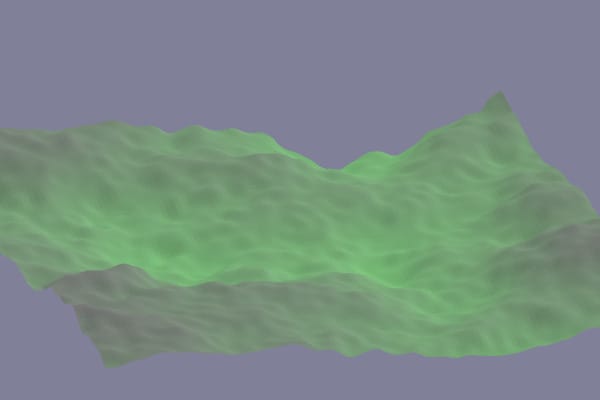

With blue noise (positive exponents) the new renderer looks much better:

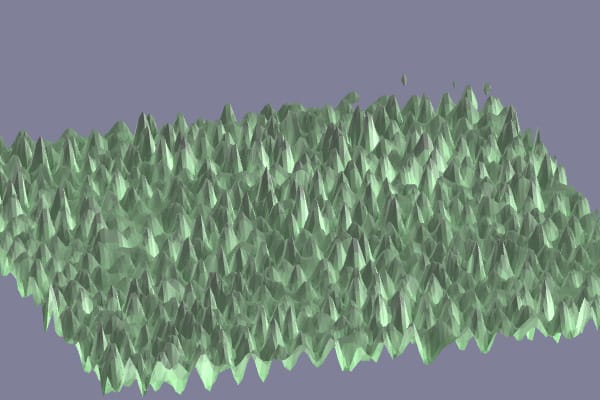
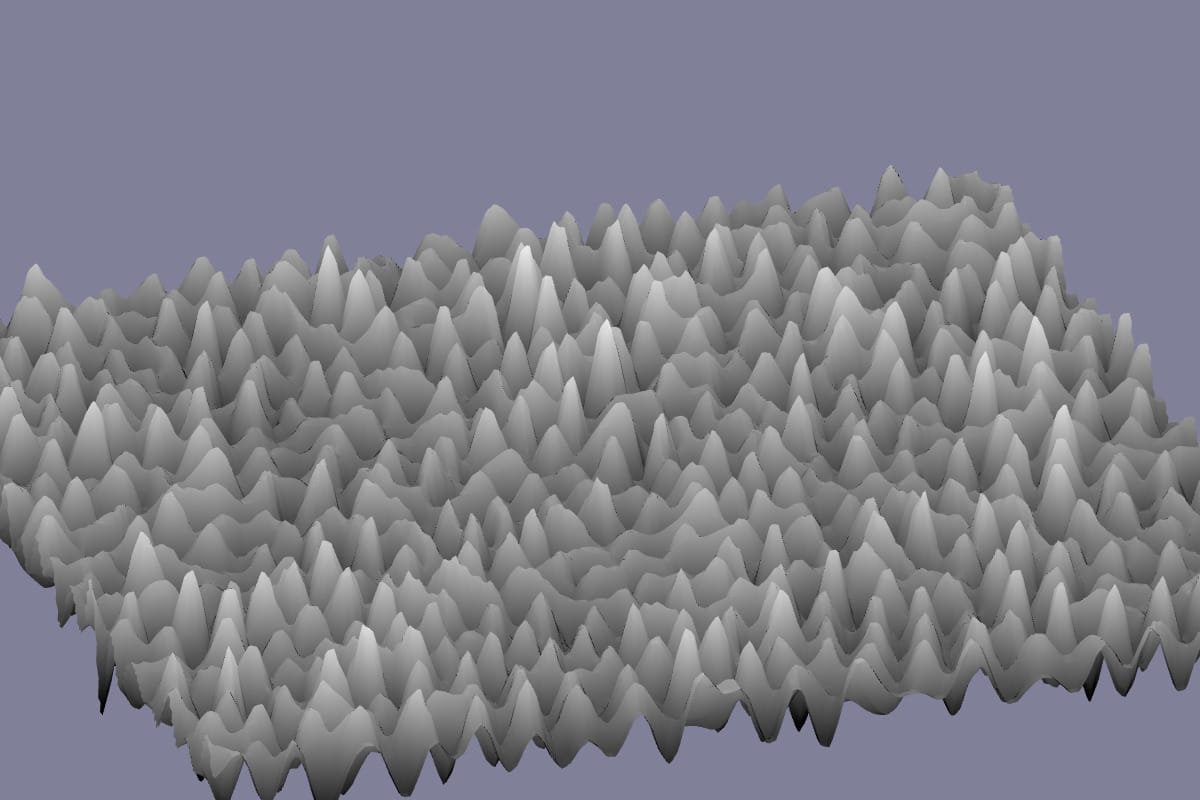
I'm really really happy with outlines! Compare:

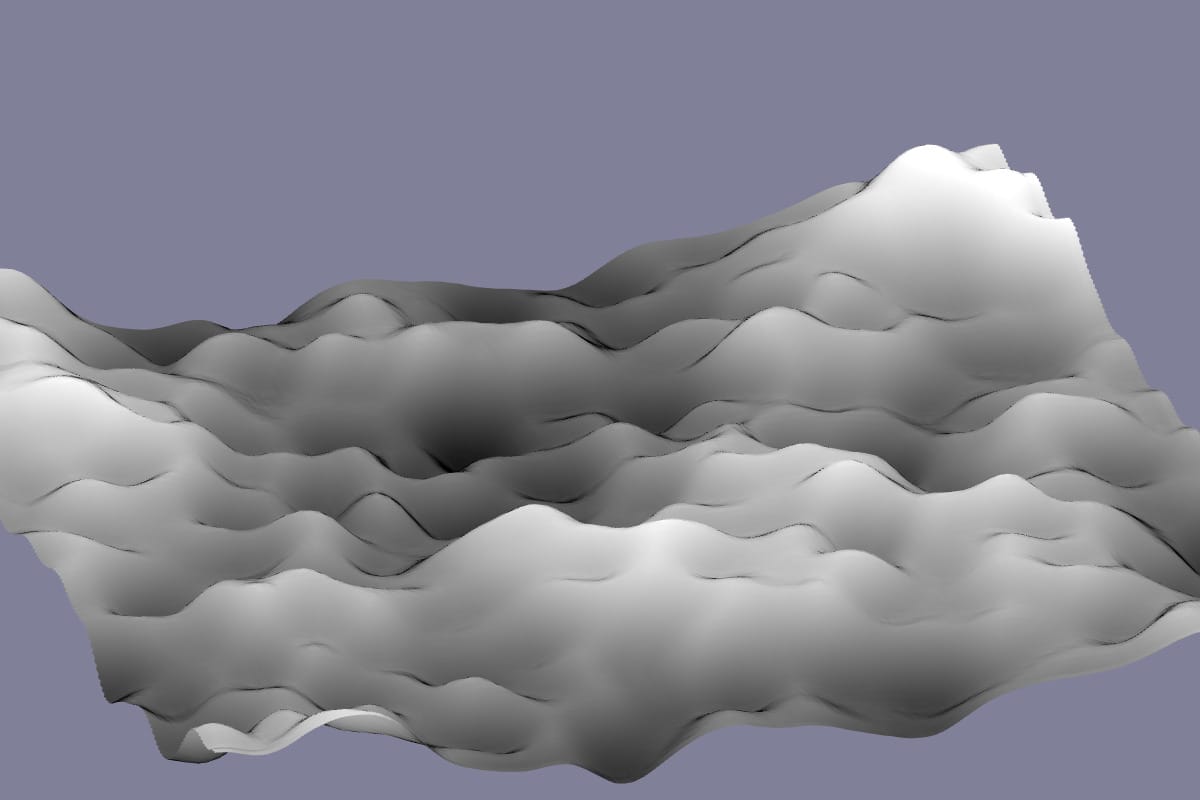
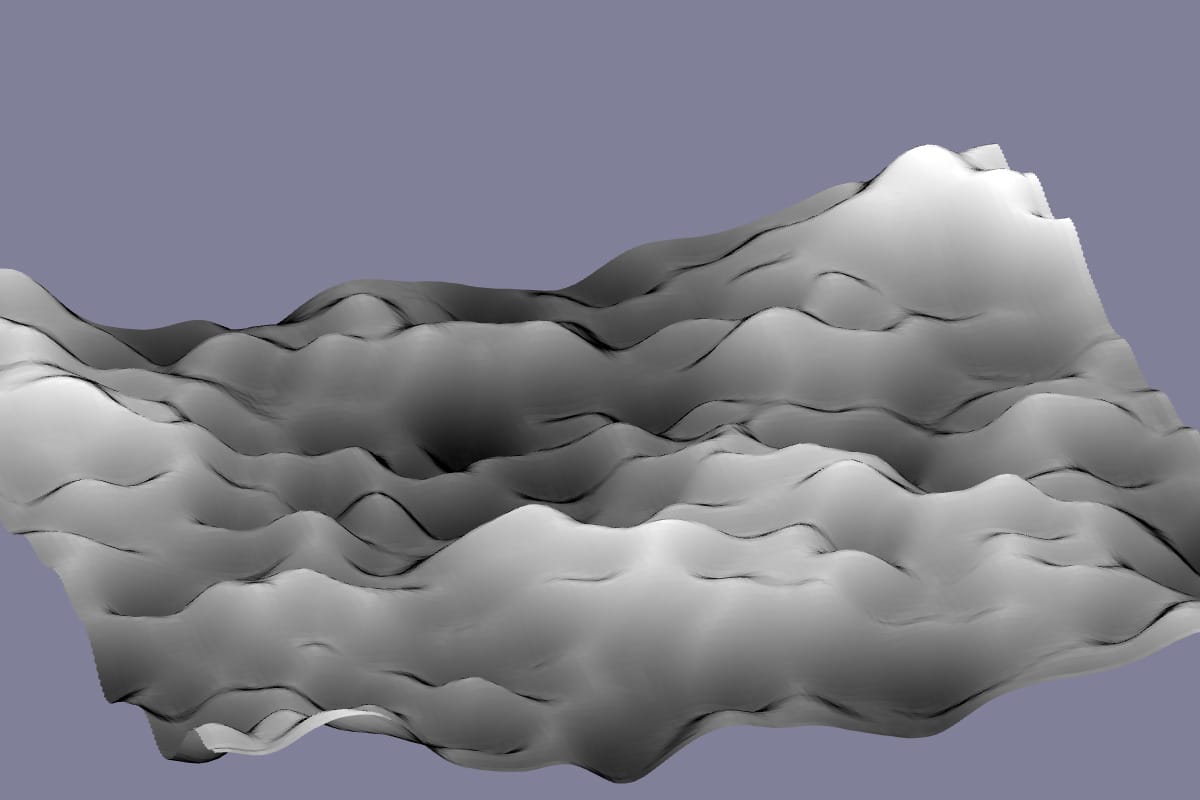
The outlines are one line of code:
void main() { float light = 0.1 + z - fwidth(z) * u_outline; gl_FragColor = vec4(light, light, light, 1); } I darken the color based on fwidth(z). The GL extension OES_standard_derivatives calculates how much an expression changes from the current pixel(fragment) to adjacent pixels. When z changes a lot, that usually means it's changing from one mountain peak to another, so I darken the output color.
There are still more things I'd like to improve on this page, but the renderer was the thing that bothered me the most, and I'm now happy with it. The other changes will wait until another day.
Portal 2 With Delicious Collaboration Beers
Paul had the wonderful idea of pairing a game that hinges on collaboration with a couple of beers that are collaborative efforts between breweries. As of recently, the craft beer industry has been cranking out beers like this, where two or more breweries get together and combine their skills to make special one-off products. The first we opened was Brux, a collaboration between two of California's most influential breweries.
Brewed by Sierra Nevada and Russian River Brewing, Brux is a Belgian-style farmhouse ale. It is pale in color and effervescent, with a funky, subtly fruity nose. It tastes of pepper and citrus fruit, with a hint of peach. It finishes dry, with lingering grassy notes.
The second beer Paul brought was Shewolf India Pale Ale, a collaboration between Half Acre and Three Floyds. Shewolf features fruity hoppiness in abundance. It tastes strongly of grapefruit with some tropical fruit notes in the background. Both Shewolf and Brux made great companions for Portal 2. While the breweries' collaborations had much better results than Paul's and mine did when it came to advancing quickly through the game together, the reasonably strong beers made it more fun for us to yell at each other.































